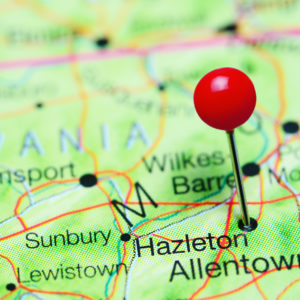Each time I go to Hazleton, Pennsylvania, I walk away thinking of it as a place of renewal and hope, a city that is slowly fusing its past and present into a new identity that will set it apart from other cities in the region and give it a platform for the future.
But it wasn’t always that way. When I started visiting Hazleton over eight years ago as part of a book project, I saw it as a place of division and dissonance.
The city had leapt onto the frontlines of the national immigration debate in 2006 by passing local ordinances that required employers to check the immigration status of new employees and landlords of potential renters. Protests erupted for and against immigration, and the national media covered them closely. Finally, the courts struck down the ordinances and ruled that the city had overstepped its authority in passing local immigration enforcement legislation.
Since then, Hazleton has been coming to terms with immigration in less public, often challenging, ways. Between 1990 and today, it has gone from a city that was overwhelmingly white and native-born to a city that is roughly half-Latino, with numerous immigrant families.
The overall outcome has been positive for the city, which is living through an economic revival. But native-born residents and newcomers have had to negotiate a difficult pathway to begin to imagine a shared future.
Like many smaller cities, Hazleton was built on immigration a century ago. Native-born Hazletonians still speak about their European immigrant roots as though their families’ arrival happened yesterday.
Their town also once was a relatively prosperous coal mining town and a significant regional center. But starting in the 1950s, the coal mines’ slow decline undermined Hazleton’s place in the world. An exodus of younger residents to larger cities continued at least through the 1990s.
By the late 1990s, though, Hazleton had started to attract new factory and warehouse jobs. They were supposed to keep the next generation at home, but they also attracted Mexican and Dominican immigrants from the New York City area.
Hazleton suddenly added new cultural layers to its immigrant past. The tensions were visible quickly. Schools struggled to deal with parents and some children who spoke little English. Neighbors clashed over different norms about when and how loud to play music and how many people could live in a home.
A 2006 killing of a native-born resident by two Dominican immigrants set off demands by the mayor to ban unauthorized immigrants. And in 2008, a group of white teenagers beat a young Mexican immigrant to death in the next-door town of Shenandoah while shouting ethnic insults at him. More even than strains on public services or differing community norms, these killings marred the relationship between newcomers and native-born residents.
Then something remarkable, yet also surprisingly common, started to happen. As immigrants moved in, Hazleton started to grow again. Not just in population, but economically.
Small businesses sprung up throughout the city. The old downtown started to come back. Traditional Hazleton families still run the city’s largest enterprises, but the small businesses that now dominate the city’s principal commercial corridors almost all have Spanish-language names. In five years, there were 60 new businesses, including a high-tech company started by a Mexican entrepreneur and his dual-citizen son. This is not surprising since studies show immigrants are nearly twice as likely as native-born Americans to start a business.
Not everyone is happy, but it’s not hard to feel the momentum shifting. Latino residents exude an optimism about their newfound city that must rival that once felt by Irish, Italian and Eastern European immigrants. The Latino residents remember their rocky welcome from a few years back, but they express a pride in their adopted city that rivals that of native-born residents. And increasingly, many native-born residents are finding new optimism.
Some of what changed is simply time. Studies show that actual contact with immigrants helps people develop more positive attitudes toward them, and that immigrants integrate better when they are immersed in the same institutions as the host community.
At the same time, intentional efforts to bridge the divides have helped to knit these two groups together. For example, the Hazleton Integration Project started by the city’s most famous resident, Chicago Cubs Manager Joe Maddon, has played a dynamic role in building bridges.
The divides may remain, perhaps for another generation. But the inertia seems to be firmly on the side of a future that embraces the city’s old and new immigrant cultures, along with its strategic location and entrepreneurial energy.
Over time, I suspect that Hazleton will no longer be known as a political bellwether but rather as a symbol of what cities can do to renew their energies and create an inclusive identity even amid rapid demographic change.

